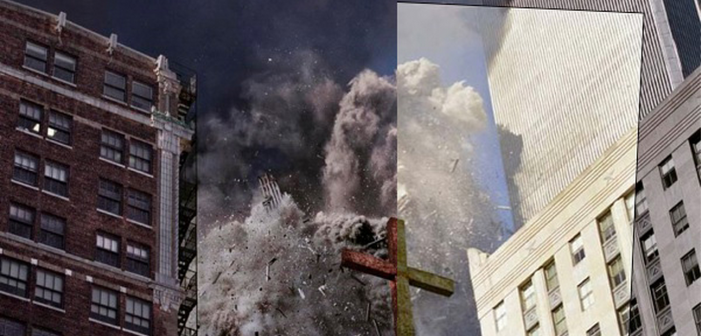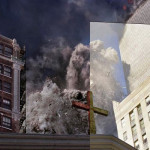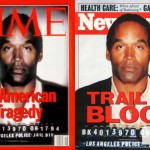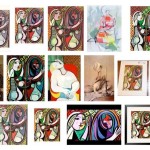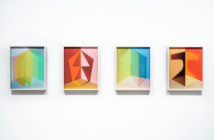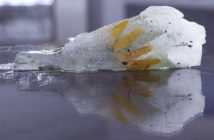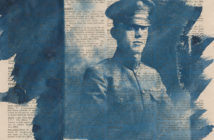Click over to the article to see the images paired 2001/11.
In the BagNews piece, Shaw does a lot of re-blogging of various sides of the critique, with the ultimate question being: Is this ethical?
I think there are several layers of interesting discussions to have here. The first, which is addressed in the piece, is about the form of presentation. Shaw quotes a commenter who says:
When he was shooting thousands of pictures on the day of the disaster, how was he transmitting the data as he ran around? Did he have any time to review the images that editors were selecting and have the opportunity to say "hey, those are too bright – the scenes in real life were darker, knock them down a bit"? Without more info there is no way to assume that the original images are more authentic than the ones that have been recently printed with evident care.
I agree with this assessment, in large part because it fits with what we all take for granted when looking at images in different contexts. Whether we think about it or not, we intuitively know that images reproduced in print appear different than on the web. We know that the versions of a photograph (or painting or sculpture or whatnot) that appear on a gallery website do not look exactly the same as the original. Even the most meticulously-produced artist monograph will still have some variation, and we accept this. Of course, all artists want their work shown the best it can, and I know from experience how much effort is put in on all sides to get things as close as possible, but at the end of the day our relationship with publication contains an intuitive acknowledgement of the variation of process.
What this raises for discussion is the question: once an image is printed, is the creator bound to the printed version? In other words, once Nachtwey's photos were printed in the days after 9/11, was he bound to accept those versions as permanent and forever unchangeable?
The second question this raises concerns intentionality. Were the changes made to Nachtwey's photos destructive to their original intent? Looking over the images available at BagNews I don't see any changes that alter the meaning of the images. Some show more detail or more color saturation, others are darker than the 2001 versions, but they still convey the scene and while the changes offer more impact, they don't alter the intent. That is my personal interpretation, and others may see it differently, but I wasn't left with any overwhelming sense of a breach of ethics.
Compare this to the infamous photo of O.J. Simpson's mug shot on the cover of TIME in June of 1994. This image was deliberately darkened by an editor to make O.J. appear scarier, more criminal. The alteration raised all sorts of questions at the time about race, but also about the intent of the manipulation. The darkened image changed the perception of O.J. in a substantive way. This change to the actual meaning of the image was further dramatized by the fact that Newsweek ran the same photo, unaltered, on their cover that same week.
Pulling back a little bit further, the questions around Nachtwey's 9/11 photographs strike at a much deeper divide than the BagNews article addresses. Assuming Nachtwey was completely happy with the presentation of his images in 2001, and re-visited them 10 years later and decided to make new versions that he also thinks represent him, is that acceptable? At what point did Nachtwey lose the right to edit his own work?
Let's set aside the question of whether or not he should have made the changes for the moment. Focusing on his rights as the creator of the photos, was there a point that he lost the creative control of his images? As I pointed out above, one could argue that their publication in 2001 made them public and one could argue that he is bound to those versions. Yet another argument could be made that the new images are the "true" representation of his vision. A third argument could be made that the only "true" versions of these images are those printed by Nachtwey with his own hands in a darkroom or computer lab to be exhibited publicly. A fourth argument is that the unaltered negatives or RAW files from his camera are the only "authentic" versions of these images.
You could also say none of these are true. Or all of them.
There is an idea that at some point art becomes fixed. We don't imagine that an artist wants to update a finished work, and there is a myth of genius around art that says that an artwork eventually becomes permanent. There are financial reasons for this, historical reasons, creative reasons and the general human need to move on to other endeavors.
In truth artworks are updated and changed all the time. Often this is for preservation or restoration. Sometimes it is for artistic integrity. As but one example, Mags Harries and Lajos Héder re-made their 1976 public installation "Asaroton" in Boston's Haymarket district in 2006 after the area was rebuilt in the Big Dig. While the physical results might be harder to identify, it seems impossible that Harries and Héder would not have taken advantage of 30 years of improvements in the casting process and the quality of materials available. The new "Asaroton" must be an improvement on its predecessor. This isn't to disparage Harries and Héder but to point out that what Nachtwey did is not dissimilar. He used digital tools unavailable in 2001 and better workflows to get a new result from the same source.
Ultimately though, my last question is: Do you think Nachtwey should have updated his images? If so, why is it justifiable? If not, when did he give up his creative agency?
- One of James Nachtwey’s famous 9/11 images, with a portion of the 2001 version overlaid on the 2011 version. Source images via BagNews. Photos copyright 2001/2011 by James Nachtwey.
- This screenshot from Google shows the incredible amount of variability in image reproductions that we casually accept.
All Nachtwey images are copyright 2001/2011 by James Nachtwey. Images via BagNews.

